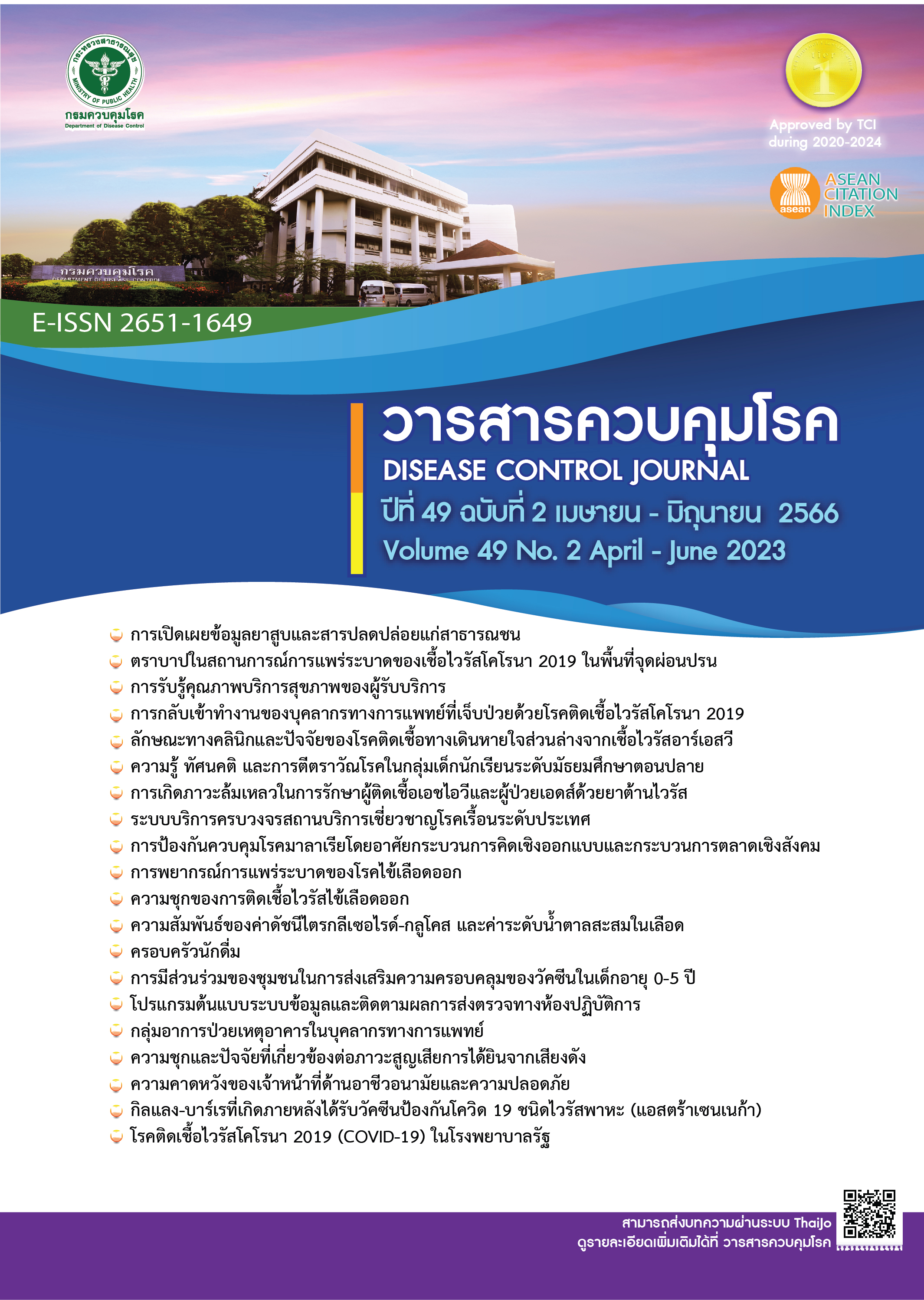The factors associated with unsuppressed viral load in HIV-infected patients at the first antiretroviral therapy in Hatyai hospital, 2020
DOI:
https://doi.org/10.14456/dcj.2023.27Keywords:
factor, antiretroviral treatment failure, HIV/AIDS patientsAbstract
HIV-infected patients with unsuppressed viral load after initial antiretroviral therapy have a potential for HIV resistance, increased transmission and will be at an increased risk of opportunistic infections that affect the overall quality of life. This study aimed to determine the incidence and factors associated with unsuppressed viral load in HIV-infected patients 6 months after initiation of antiretroviral therapy in Hatyai hospital. A retrospective analytical study was conducted by retrospectively collecting the data on HIV/AIDS patients aged >18 years old, who started antiretroviral therapy between December 2019 and December 2020 and continued taking medicines for 6 months, in order to determine the factors associated with unsuppressed viral load. The association of the data was reported with odds ratio. The correlation of variables was analyzed by multiple logistic regression method with statistical significance when p<0.05. Findings from the study indicated that 168 HIV/AIDS patients had been identified. Of these, 30 had unsuppressed viral load and 138 had achieved viral load suppression. Factors associated with treatment failure with statistical significance based on multivariable analysis included CD4<200 cells/mm3 prior to initiation of antiretroviral therapy (adjusted odds ratio 4.46, p-value 0.01, 95% CI 1.44-13.77) and compliance <95% (3.32, p-value 0.01, 95% CI 1.35-8.14). Conclusion: Factors associated with HIV/AIDS patients with unsuppressed viral load were CD4<200 cells/mm3 before initiation of antiretroviral therapy and compliance<95% with statistical significance (p<0.05).
Downloads
References
Bureau of AIDS, TB and STIs Thailand. Thailand national guidelines on HIV/AIDS treatment and prevention 2017 [Internet]. 2017 [cited 2022 Jun 3]. Available from: http://www.thaiaidssociety.org/images/PDF/hiv_thai_guideline_2560.pdf. (in Thai)
John-Stewart G, Peeling RW, Levin C, Garcia PJ, Mabey D, Kinuthia J. Chapter 6: prevention of mother-to-child transmission of HIV and syphilis. In: Holmes KK, Bertozzi S, Bloom BR, Jha P, editors. Major infectious diseases. 3rd ed. Washington DC: The International Bank for Reconstruction and Development/The World Bank; 2017. p. 113-36.
Oonkatepon S. Factors associated with virological failure in AIDS and HIV patients in Akat-amnuay Hospital. Journal of the Office of ODPC7 Khon Kaen. 2015;13(3):47-57. (in Thai)
World Health Organization. Updated recommendations on HIV prevention, infant diagnosis, antiretroviral initiation and monitoring [Internet]. 2021 [cited 2022 Jun 3]. Available from: https://www.who.int/publications/i/item/9789240022232
Hicham T, Ilyas E, Tarik H, Noureddine B, Omar B, Rachid F, et al. Risk factors associated with unsuppressed viral load in HIV-1 infected patients at the first antiretroviral therapy in Morocco. Int J Mycobacteriol. 2019;8(2):113-7.
WHO Expert Consultation. Appropriate body-mass index for Asian populations and its implications for policy and intervention strategies. Lancet. 2004;363(9403):157-63.
Midkhuntod J. Factors Affecting Virological Failure of HIV/AIDS patient in Takhli hospital, Nakhonsawan Province. Region 3 Medical and Public Health Journal. 2019;16(2):65-75.
Robbins GK, Daniels B, Zheng H, Chueh H, Meigs JB, Freedberg KA. Predictors of antiretroviral treatment failure in an urban HIV clinic. J Acquir Immune Defic Syndr. 2007;44(1):30-7.
Datay MI, Boulle A, Mant D, Yudkin P. Associations with virologic treatment failure in adults on antiretroviral therapy in South Africa. J Acquir Immune Defic Syndr. 2010;54(5):489-95.
Tuboi SH, Harrison LH, Sprinz E, Albernaz RK, Schechter M. Predictors of virologic failure in HIV-1-infected patients starting highly active antiretroviral therapy in Porto Alegre, Brazil. J Acquir Immune Defic Syndr. 2005;40(3):324-8.
Downloads
Published
How to Cite
Issue
Section
License
Copyright (c) 2023 Disease Control Journal

This work is licensed under a Creative Commons Attribution-NonCommercial-NoDerivatives 4.0 International License.
Articles published in the Disease Control Journal are considered as academic work, research or analysis of the personal opinion of the authors, not the opinion of the Thailand Department of Disease Control or editorial team. The authors must be responsible for their articles.






